A Machine Operator Died When Caught in a Plastic Injection Molding Machine
California Case Report: 03CA004
Summary
A 29 year-old Hispanic male machine operator died when caught between the injector and the housing of a plastic injection molding machine. Evidence suggests the victim was performing maintenance and reached into the machine while it was running. According to the employer, the victim’s duties did not include machine maintenance. The victim had not completed machine- specific training at the time of the incident. The safety interlock device on the hinged shield for the injector was not working, and the maintenance log did not document when the last inspection of the safety devices occurred. The CA/FACE investigator determined that, in order to prevent future occurrences, employers, as part of their Injury and Illness Prevention Program (IIPP), should:
- Ensure machine operators are properly trained on machine operation and safety and their achievement of skills is verified through a testing program.
- Ensure all machine safety interlock devices are in working condition.
- Ensure employees stay within their assigned scope of work.
Introduction
On March 28, 2003, at approximately 2:30 am, a 29-year-old Hispanic male machine operator was killed when he was caught between the housing and injector of a plastic injection molding machine. The CA/FACE investigator learned of this incident on April 10, 2003, through the Legal Unit of the Division of Occupational Safety and Health (Cal/OSHA). On May 1, 2003, the CA/FACE investigator traveled to the victim’s place of employment where he interviewed the company vice president and other employees in the plant. The investigator also inspected the incident site and took pictures of the machine involved in the incident.
The employer of the victim was a worldwide industrial manufacturer of plastic products for home, office and industrial use that had been in business for over 30 years. The manufacturing plant where the incident occurred had been in operation for 10 years and had approximately 45 employees. There were 7 employees at the shop when the incident occurred. The victim had been employed with the company for 3 weeks.
The employer of the victim had a written safety program. There were written task- specific safe work procedures for tasks performed in the shop. Safety meetings were held quarterly and were documented. The company had a training program that was usually accomplished by hands-on training through plant supervisors. Every employee had a file called a “safety training jacket” which documented the training received and who gave the training. It was the supervisor’s responsibility to perform the initial training for new employees and observe their performance for proficiency. The victim had completed the initial general training and was in the process of machine-specific safety training when the incident occurred. There was no testing program to verify the victim’s knowledge and safety skills on the machine, only his proficiency for producing a product. Refresher training was offered on an annual basis.
The victim was born in Guatemala and came to the United States in 1990. He spoke English and when he applied for the position he occupied, he completed all the forms in English. The victim had a 12th grade education. According to his supervisor, language was not a barrier to communicating with the victim.
Investigation
The site of the incident was a manufacturing plant of plastic products for home, office and industrial use. On the day of the incident, the victim was assigned to operate a plastic injection molding machine that was mostly automated. The machine involved in this incident covered an area approximately 80 feet long by 12 feet wide and 12 feet high (exhibit #1). The machine involved in the incident was molding high-density polyethylene plastic trash cans. The machine was made up of two components: an injector head and a mold frame. The end of the mold frame had a concave cone-shaped opening with a machined seat in the center (exhibits #4 & 5). The injector head end was round and mated with the mold seat. The area where these two sections met had a two-piece metal shield. The back portion of the shield was fixed parallel to the injector (exhibit #3). The front side of the shield was hinged to allow access to the junction between the mold and the injector for maintenance (exhibit #2). The hinged shield was equipped with an interlock safety switch which was supposed to shut down the machine when open (exhibit #6). The safety interlock was not working at the time of the incident.
The cylindrical injector head took raw plastic pellets and heated them to a molten state (365-392 degrees F). During the cycling of the machine the hot injector head moved in toward the mold and mated against the machined surface, injecting the molten plastic into the mold. Once the injection was completed the injector head retracted from the mold while the product cooled and hardened. The machine cycled automatically every 3.5 minutes.
On the day of the incident, the victim was assigned to the machine, and his duties consisted of removing the product from the conveyor belt, trimming the excess plastic off the product, and then stacking it. The victim reported to work at 11:00 pm, and was supposed to work until 7:30 am. The victim’s supervisor stated that he was walking around the shop checking on all the employees and last noticed the victim at approximately 2:00 am. At approximately 2:30 am, the supervisor noticed the victim’s machine was not cycling so he went to investigate. He found the machine running but the victim wasn’t at his operating station. As the supervisor came around the front of the machine he saw the victim trapped in between the cone shaped end of the mold frame and the mold injector. It is unknown why the victim entered this area. The supervisor immediately called 911. Because of the hot molten plastic, access to the victim was not immediate. The Fire Department Heavy Rescue team finally gained access to the victim at 3:47 a.m. and found no pulse or respirations. The City Fire Department Rescue Paramedics pronounced death at 3:48 am.
Cause of Death
The cause of death, according to the death certificate, was thermal burns.
Back to Top
Recommendations/Discussion
Recommendation # 1: Ensure machine operators are properly trained on machine operation and safety and their achievement of skills is verified through a testing program.
Discussion: When the effects of training are measured through supervisor’s observation, the only assurance an employer receives is that the worker is proficient on how to operate the machine in order to produce a product. Productivity does not measure an employee’s knowledge of all the features of the machine, only those necessary to achieve a specific goal. In this incident, the victim did not complete all of the specific machine safety training prior to beginning work. Training should be verified through a program that assures employers that employees are not only experienced in the machine operation, but also knowledgeable of all the machine’s safety features and that they attain the necessary skills to perform them when necessary. In this incident the victim gained access to an area that was restricted. A verified safety training program would have assured the employer the victim had knowledge and was aware of this limitation. Had such training been made available for this employee, this incident might have been prevented.
Recommendation #2: Ensure all machine safety interlock devices are in working condition.
Discussion: The machine involved in this incident had a safety interlock device attached to the front side hinged metal shield. This device should have automatically shut off the machine when the victim opened the hinged shield to gain access to the injector. This device was non-operative. Safety devices should be checked daily to assure their working order. A log should also be kept documenting these daily checks. Workers should not be allowed to operate machines that have identified hazards such as disabled or inoperative safety interlock devices. Had this machine been properly maintained or removed from service until maintenance was completed, this incident might have been prevented.
Recommendation #3: Ensure employees stay within their assigned scope of work.
Discussion: In this incident, the victim entered an area that was not in his scope of work. Employers should use a check off sheet for a new employee to verify he understands what the scopes of his duties are. Employees who are not fully trained should be kept under close supervision. Safe work practices can be assured through programs of training, supervision, rewards, and progressive disciplinary measures.
Exhibits
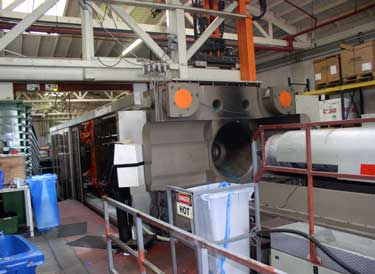 |
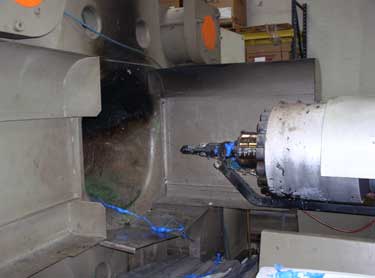 |
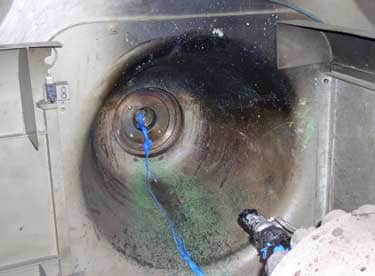 |
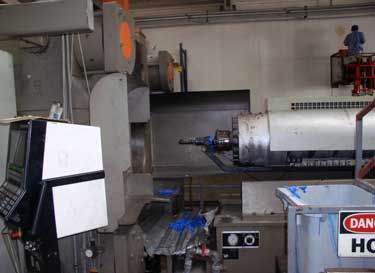 |
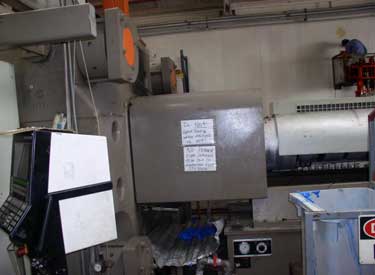 |
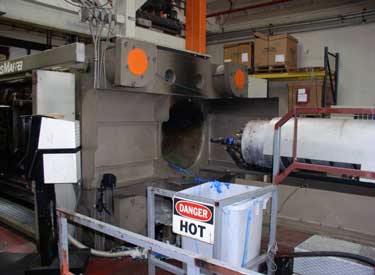 |
|
Exhibit #6. View of the injector mold that injects the heated plastic into the mold. |
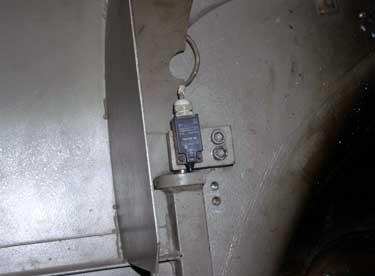 |
|
Exhibit #7. View of the safety switch that cuts the power to the machine when the door is open. |
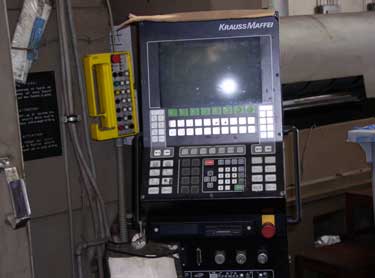 |
|
Exhibit #8. View of the control panel for the machine.
|
Reference
- California Code of Regulations, Vol. 9, Title 8, Sections 4208, 4600, 4601
California Fatality Assessment and Control Evaluation (FACE) Project
The California Department of Health Services, in cooperation with the California Public Health Institute, and the National Institute for Occupational Safety and Health (NIOSH), conducts investigations on work-related fatalities. The goal of this program, known as the California Fatality Assessment and Control Evaluation (CA/FACE), is to prevent fatal work injuries in the future. CA/FACE aims to achieve this goal by studying the work environment, the worker, the task the worker was performing, the tools the worker was using, the energy exchange resulting in fatal injury, and the role of management in controlling how these factors interact. NIOSH funded state-based FACE programs include: Alaska, California, Iowa, Kentucky, Massachusetts, Michigan, Minnesota, Nebraska, New Jersey, New York, Oklahoma, Oregon, Washington, West Virginia, and Wisconsin.
To contact California State FACE program personnel regarding State-based FACE reports, please use information listed on the Contact Sheet on the NIOSH FACE website. Please contact In-house FACE program personnel regarding In-house FACE reports and to gain assistance when State-FACE program personnel cannot be reached.
